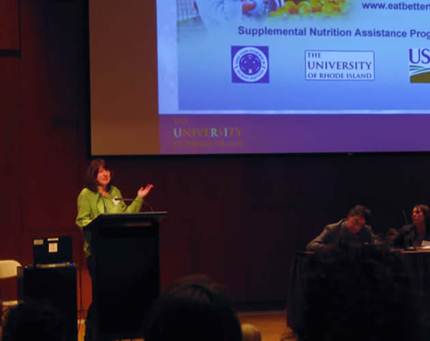
“There are currently 155,000 people participating in the SNAP Program and while that number may be an indicator of high need, it is also an indicator of great success.”
– Hunger Center Director, Dr. Kathleen Gorman
“We sit behind the giants on whose shoulders we stand,” said Dr. Deborah Frank. The keynote speaker on domestic hunger was referencing the huge amount of advocates, doctors, researchers, and government representatives who fight on the front lines battling domestic and global hunger and who were there at the Hungry for Answers conference to share their stories.
The Solomon Center at Brown University was host to speakers and panelists ranging from world-travelled doctors, to college professors, to young graduates from Brown all there to share their stories, their research, and their advice for bettering the lives of millions of people all over the world.
Among the many speakers, The Hunger Center’s own Director, Kathleen Gorman, gave a presentation about the SNAP Outreach program at URI and the involvement of students in our work. Dr. Gorman proudly reported that last year the SNAP Hotline received 3,300 phone calls and Outreach workers met with over 14,000 individuals from 1,500 different sites. She emphasized the importance of participation in SNAP, which is one of the many programs slated for financial cuts in the 2011 fiscal year.
Other panelists included James Arena-Derosa, a Regional Administrator from the USDA who received some heated questions about their plans to keep people’s health their main priority. On the global panel, a young recent Brown graduate named Emma Clippinger, informed the audience of her non-profit organization Gardens for Health International operating in Rwanda, which she founded when she was still a student.
Topic discussions ranged from the cycles of malnutrition and infection both locally and globally, the cycle of food, housing, and energy insecurity, the puzzle of poverty and obesity, increasing availability and intake of fruits and vegetables with local programs like “Fresh to You”, and government initiatives like Hillary Clinton’s “1000 Days.”
Along with the multiple speeches and panel discussions, several short films were shown by Doctors Without Borders portraying images ranging from rural families in Pennsylvania struggling to keep their fridges full, to children in Bangladesh whose tiny, broken bodies are just another picture of normality. Dr. Deborah Frank worded it best: “Public hardships and economic conditions are written on the bodies of babies.”
The range of advocates young and old, governmental and grassroots, domestic and global all gathered in this one place was an important reminder that the fight against hunger comes from many angles, in many forms, through many faces, which was fitting considering the crisis of hunger and food insecurity works much in the same way.
(March 2011)

